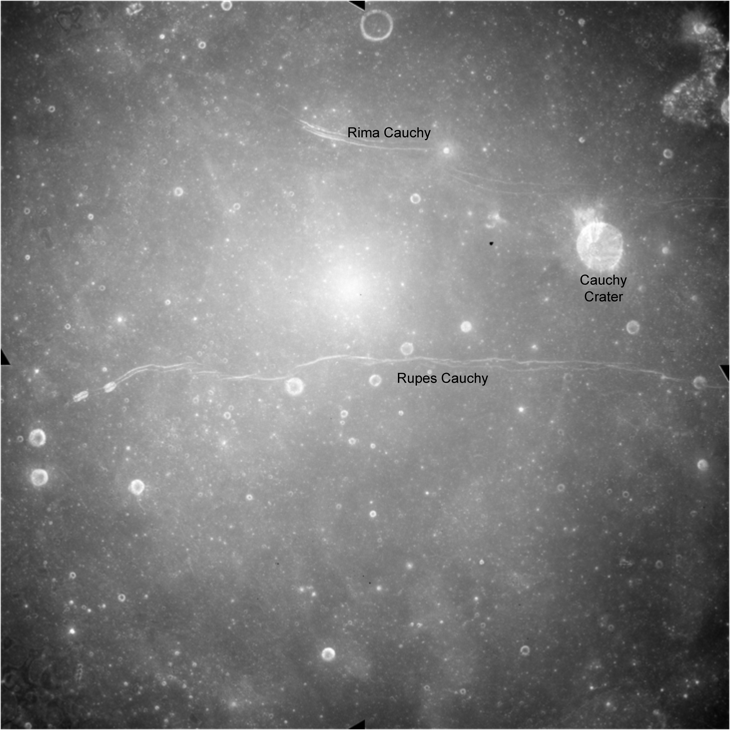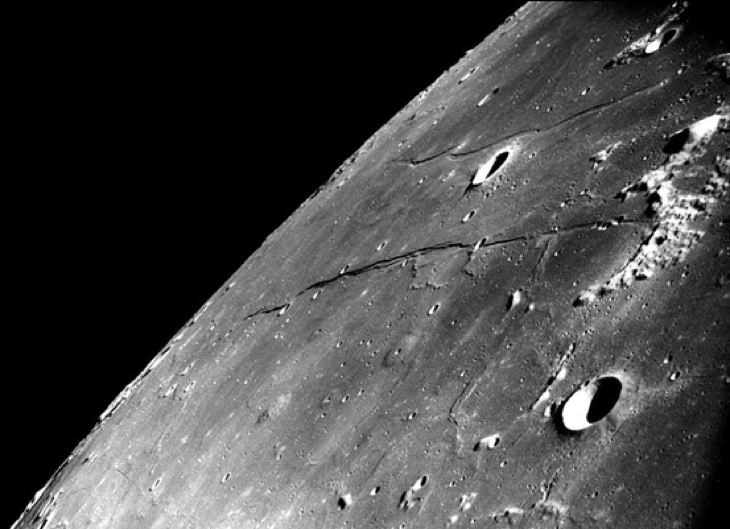
| Project Home | About the Scans | Browse Gallery | Image Map | Support Data | Resources | Ephemeris |
Featured Image - 09/02/2008
Geology of the Cauchy Region
Eastern Mare Tranquilitatis includes multiple features that reveal clues to the geologic history of the Moon. Cauchy Crater appears as the bright circular feature in the eastern portion of the image and it is bounded to the north and south by linear features. Rima Cauchy to the north is a 210 kilometer long graben- a tectonic feature where both sides are steep-walled parallel faults. In this case, the graben was most likely formed by the weight of the mare materials causing the surface to drop down between the faults. Rupes Cauchy to the south is a 120 kilometer long fault scarp. Both graben and scarps are expressions of extension of the surface. The bright spot that dominates the western portion of the image is caused by the opposition effect, which occurs when an airless rough surface is observed under high incidence angles. The phenomenon shows the subsolar point- where the sun is perceived to be directly overhead.
Figure 1: Apollo Image AS15-M-2019 of Crater, Rima, and Rupes Cauchy. These features show the once dynamic nature of the surface of the Moon. [NASA/JSC/Arizona State University]
This spectacular oblique view of eastern Mare Tranquilitatis was taken at a low sun angle by Apollo astronauts using a handheld Hasselblad camera. Viewing the region across the limb at a low sun angle dramatically increases the detail that we can see. Taking images of the surface under different lighting conditions is essential to studying the surface of the Moon. In this view, you can see two small circular features south of Rupes Cauchy. At first glance, they may look like craters but if you look more closely, you will notice that they are actually raised features: domes! Domes are likely of volcanic origin; they form when lava erupts slowly and piles up instead of flowing away from its vent.
Figure 2: Apollo Hasselblad image AS8-13-2344 showing oblique view of the Cauchy region of eastern Mare Tranquilitatis. [NASA/LPI]
This region will be of great interest to human explorers who return to the Moon because it exhibits such a wealth of different surface features within a short range. At this one location, explorers can study tectonic, volcanic, and impact features and how all of these features indicate the geologic history of the Moon. So many unanswered questions can be answered by exploring and sampling this one small region!
Tweet
|
|
Space Exploration Resources |
|
 LPI LPI
|

